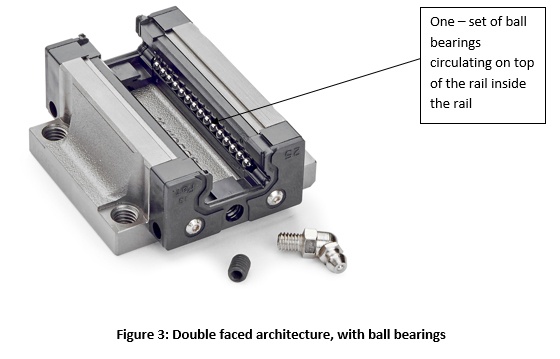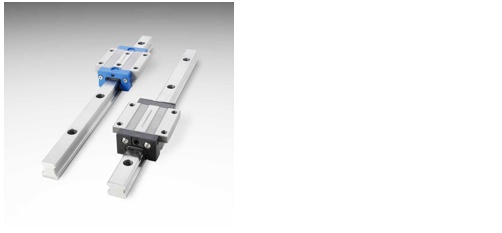By Matthew Hand
Product Line Specialist
Thomson Industries, Inc.
www.thomsonlinear.com thomson@thomsonlinear.com
When machine designers need fast, accurate control over the linear movement of the heaviest loads, they typically choose profile rail linear guides over round rail guides. Profile rails, sometimes called square rails, offer increased rigidity and stiffness over round rail products, as well as high load capacity in a small package. But profile rails can differ significantly in rigidity, load capacity, travel accuracy, smoothness of operation, speed, and come in various sizes and mounting configurations. This article compares the three most commonly used profile architectures and explores the performance trade-offs that must be considered in finding the optimal configuration for your application.
Architectural options
Profile rail architectures vary mostly in the shape and arrangement of the rolling elements. The primary options are: double back architecture with ball bearings, double back architecture with roller bearings and double face architecture with ball bearings.
- Double back with ball bearings. The double-back with ball bearings architecture uses two sets of ball bearings running back to back inside of the rail, providing high moment load capacity. (Figure 1) Support results from a ball conforming groove on both inner and outer races. The ball track groove is only slightly larger in radii than that of the balls themselves, which cradles the ball bearings as they infinitesimally flatten under load, slightly expanding the contact area between the balls and the races.

- Double back with rollers. In the double back architecture with rollers option, cylindrical rollers replace ball bearings, (Figure 2) providing even greater stability over the convex balls, which have but a single point contact area making them slightly more vulnerable to deformation under pressure. The rollers, by contrast, have a broader contacting surface across the length of the roller.
![]()

- Double face with ball bearings. The double face architecture with ball bearings uses four bearing tracks, which are deployed face to face on the top of the rail, rather than inside of it (Figure 3), The double-faced bearing arrangement results in equal load-carrying capacity in all directions. The rails are much more tolerant of mounting surface inaccuracies, but compromise rigidity and moment load capacity.

Additional features are available for specialized purposes. These include options with spacers between the bearings to reduce noise, stainless steel or chrome plate options to resist corrosion, as well as smaller and lighter profiles. Choosing which architecture is right for which application requires balancing tradeoffs in the areas of rigidity, capacity, accuracy, smoothness, size, durability and cost. Other profile architectures do exist but this article focusing on the industry leaders.
Exploring the tradeoffs
Choice of bearing architecture begins with a preliminary determination of the following information:
- The mass of the load
- The location of the load, e.g. placed on top of the carriage or to the side
- Required accuracy
- Desired travel life
- System mounting constraints
The rigidity, load bearing capacity, and tracking accuracy of the double backed architectures, make them ideal for demanding applications including high load industrial automation, machine tool equipment and precision measuring.
For the most demanding of applications, the roller bearing elements would offer even greater advantage. The rollers are more space efficient, which means they can deliver higher load capacity in a smaller footprint, which may be of value in tight quarters.
It is possible to over-specify, however. Selecting a guide with too much rigidity can decrease the allowable installation tolerances, therefore, greatly increasing surface preparation costs. If the mounting surface is not prepared properly, the guide will run rough, and need to be replaced more frequently, or commonly cause catastrophic failure of the linear bearings.
In applications where the highest levels of accuracy, capacity, and rigidity are less critical, the double-faced architectures may deliver smoother operation with less cost in product and installation costs. These might be best for industrial automation applications such as packaging equipment or food processing, where loads tend to be less and accuracy requirements are not precise.
Durability issues
All systems are designed from the strongest materials and polished to achieve minimal friction, but they will wear down over time. Durability is primarily a function of the load being moved and the number of repetitions, all of which can be calculated and predicted based on the parameters of the design.
Most equipment manufacturers define system life in terms of the length of lifetime travel. They might publish that the guide will provide 50 or 100 kilometers of travel over a lifetime of operation. However, it is important to factor in the load as well. Applied load has a direct effect on the life of a linear bearing and designers can use a higher capacity bearing than the application requires to achieve a longer travel life. The opposite can also be true but the bearing manufacturer should be consulted. It is also important to note the rated load capacity of a linear bearing is based on a published travel life and this can vary between manufacturers.
In tight space constrained applications it is possible to use smaller bearings while rating the life accordingly. Travel life will be diminished when de-rating, but it is important to ensure the customer’s requested duty cycle is still met. If the end user seeks a longer lifecycle for a high return on investment, the system or environment will need to be redesigned.
Other factors such as the type and methods of lubrication will impact durability as well, but the issues are similar for double back or double face architectures.
Installation issues
Profile rail carriages in general require more careful installation than systems using round rails, and double back architectures need more careful installation than the double faced architectures. Poor installation can affect all variables, including, and especially – stiffness, capacity, and smoothness. Profile rail designs are especially sensitive to flatness errors. If all rails are not aligned perfectly, the rails will bind up under travel, which adds unnecessary wear and tear that ultimately shortens the life of the assembly.
Surfaces must be carefully prepared or the parts may need to be shimmed and adjusted during installation. In applications running two rails in parallel, each with two carriages, which is quite common, a single mounting plate can be used to tie all four carriages together, enabling them to move in unison. Once the proper installation is completed this can help retain alignment and performance of the system.
Face to face architectures also need precise installation but tend to be much more forgiving on the installation end. Although face-to-face architectures should always be considered for applications that do not require high capacity or high precision.
Standard mounting configurations
Depending on the application, rail carriages may be mounted with or without flanges.
Flanges provide a wider mounting base, which helps keep the load on the rail. Flanges also have through-holes, so they can be mounted from the bottom or the top; which gives greater flexibility for the space.
But in some instances the flange might get in the way. An application might have a rail running at the edge of a case where there would be no room to fasten the flange, so alternative mounting configurations have evolved and these have become standard throughout the motion control industry. They include seven standard configurations: standard, standard long, narrow, narrow long, narrow high, narrow high long and narrow short. These vary in size from 15 mm to 55mm for ball assemblies and 25mm to 100 mm for roller based assemblies. Specialty sizes are available for more compact applications. Selection of sizes is dictated by the application and the physical characteristics of the end user’s application site and will present few, if any, performance tradeoffs.
Although sizes are standard, some customization might be required to meet specific application needs. The location of mounting holes may not be standard, for example. If migrating from one vendor brand to another, a special plate may have to be created.
Choice of materials
Choice of materials is another issue the design engineer will face. Most options are available in carbon steel or stainless steel for corrosive environments. There are also chromium plate options, which provide some corrosion prevention, although not as much as stainless steel.
Noise reduction
Generally, ball-based designs are more prone to noise, but ball spacer and ball chain based technology that can reduce noise by 30-40 percent are available. Some double back architectures with ball bearings; however, will offer quieter options, which incorporate spacers between each bearing.
The engineer’s judgment
Many factors affect the costs and the design of a linear guide and what we have provided here are general guidelines, meant primarily to provide an overview. For applications requiring the highest rigidity, motion engineers typically specify the double back architecture, using either ball bearings or roller bearings. For applications requiring less rigidity, they might specify what is called double face architecture, which might also be used with either ball or roller bearings. But these might not apply in all situations.
Although, the double backed architectures might, for example be best high precision, high capacity applications, the double-faced architectures might be better for applications where smooth operation and cost are drivers. There are also ways to configure double-faced architectures to make them more rigid as there are similar ways to configure double backed architectures to make them run more smoothly.
It all comes back to determining what is the intended load and where it will be placed; a specification which will likely change as tradeoffs are examined. There are also many selection tools that guide in the selection of the configurations to meet customer needs. Thomson, for example, provides tools that calculate application numbers through a comprehensive set of algorithms and compares results to a database of available technology to determine an optimized solution set.
To further assist design engineers in making the right choices, device vendors such as Thomson, provide design resources, including teams of application engineers who assist in identifying the optimal solution, technical collateral, white papers, webinars and video instruction. For examples visit the “Design Tools” section of http://www.thomsonlinear.com.
With so many options available, the final choice comes down to the engineers’ judgment and their reading of their customer’s preferences – stated and unstated -- which will result in the final design.

Title Image:
Caption: Thomson has a complete selection of rails and carriages in a broad range of styles, sizes and unique features produced to industry standard dimensions for easy retrofitting into existing applications or designing into new applications.


